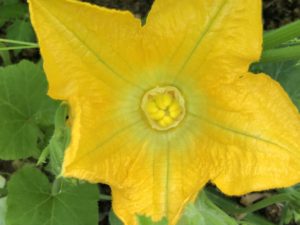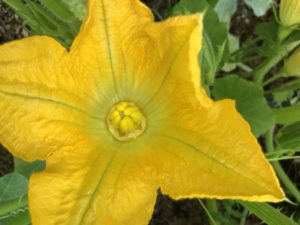The titillating title is for real, and the subject always makes someone blush. There are indeed two types of squash flowers: male and female.
The first squash flowers are usually mostly male. Females typically join the party several days to a week or more later, and it is easy to tell them apart.
(I welcome corrections to the anatomy information below.)
Male squash flowers have a single stamen, with anthers and filaments at the tip. Easily recognizable because they have a single large, erect member staring at you, looking for attention doing nothing much but trying to gain attention.


 In contrast, female squash flowers actually do something and are also easily recognizable by their three or four stigma. Below the petals of the female flower you can see the ovary which can often help you identify which variety of squash is growing. (This is particularly helpful if, like me, the squash are volunteers from the compost.)
In contrast, female squash flowers actually do something and are also easily recognizable by their three or four stigma. Below the petals of the female flower you can see the ovary which can often help you identify which variety of squash is growing. (This is particularly helpful if, like me, the squash are volunteers from the compost.)
“Striped cucumber beetle” by Katja Shulz is licensed under CC BY 2.0
All of this brings me to the more immediate concern: Striped cucumber beetles.
This morning, June 27, is the first day I found cucumber beetles in the squash (but happily not on any cucumbers). These bastards spread Bacterial wilt (Erwinia tracheiphila), which can kill your squash in a week or so. The plants start to look like they need more water, which they do, but watering doesn’t help because the plant’s vascular system has been destroyed by the beetles. Once infected, your plant is toast.
There are several things you can do to reduce the threat – here’s what generally works for me:
- Early morning and around dusk, when the temperatures are cooler and the beetles are more lethargic, look for them. They stand out easily in the flowers and (with some of the larger flowers) you can often turn the flower over and tap them into your hand before squishing them. If they refuse to budge, I’ll sometimes tear flower petals to gain access to the beetles.
- I spray the plants with Surround, which is kaolin clay (the same stuff used to make masks). When the beetles travel and/or begin to eat the squash plants, they get the clay on them and immediately begin to clean themselves, but they get more clay on them and continue to clean. Apparently they clean so much that they don’t eat and die. I don’t feel bad at all.
I also use Surround on my potatoes (to reduce flea beetle damage) and my apples (for a variety of pests), so this gets a lot of use in gardens I tend.
- Some other plants that may be weeds (looking at you, Tomatillos), can also be attractive to cucumber beetles. You can either use them as a trap crop (crush all the beetles on the tomatillos, lather, rinse, repeat) or remove them so you’ve got fewer plants to attract them.
Yellow sticky traps, similar to the traps for Japanese Beetles, do more damage than they’re worth for most home gardeners. Putting the attractant in your garden is asking them to visit. (On farms the traps can be useful for monitoring purposes.)
Unfortunately I haven’t seen Surround for sale in any stores. I purchased a 25 lb bag a few years ago through MA NOFA’s Bulk Order program and I’m still working my way through it. It was expensive, but given how many years it has lasted and how many plants it helps protect and that it doesn’t harm any beneficial insects (as long as you don’t spray any bugs directly), I think it is worth it. If you have found Surround anywhere locally, please let us know in a comment below.
There are also several pesticides you can use but most of these will affect beneficial insects in addition to the beetles. You can also choose parthenocarpic squash varieties that do not require pollination and simply cover everything in netting, as long as the beetles haven’t overwintered in the soil where your squash is growing. I’m only aware of parthenocarpic cucumber varieties though and not any other types of squash.
Check for beetles ASAP!



